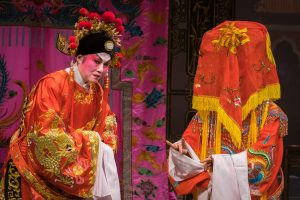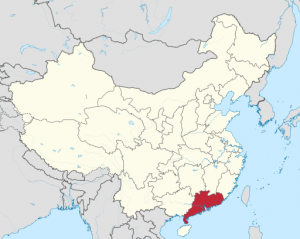OVERVIEW: Cantonese opera has been performed since the 13thcentury. This stylistic theatre incorporates elaborate makeup, costume, music, and movement to convey its moral message to the audience. Still performed today, Cantonese opera has evolved to remain popular in Hong Kong and beyond.

Introduction
When hearing the term opera, the first thing that comes to mind in the majority of people is the classical musical tradition in Western cultures that typically involves high-pitched singing. Cantonese opera is a form of theater in Hong Kong that combines the linguistic tones of text with the melody of singing (Yung, 1989). Debatedly beginning in the late 13th century, Cantonese opera was on the rise as the country’s multicultural crowd grew. While Cantonese opera readily changes and adapts to the current tastes of audiences, the main elements of the play remain. The visual elements of makeup, costume, and movement allow actors to tell a story and tell a moral message of “how to be a good person.” These operas range from drama to romance to tragedy and incorporate multiples facets of instrumental combinations and musical elements. Tong Dik Sang’s famous opera, The Flower Princess, released in 1957, has many similarities and differences to operas being performed today. The rise of children performance groups has kept the popularity of opera alive and as recent as 2017, an opera was performed without any words or song, which are typically seen as essential elements to what an opera is (Citymag, 2017). Through the urbanization and catering to commercial theater, Cantonese opera has experienced fluctuation in its popularity and true meaning. This will assess the main components of what Cantonese opera was, through its beginning history and an analysis of The Flower Princess, to what it is today.
The History
There are over 350 varieties of Cantonese opera that combine different styles of song and speech. It is of national and global importance, as it stems from Chinese traditions and faced massive changes during shifts in political power and governmental rule. There are multiple forms of Chinese opera, the most influential being Kunqu (performed under the Ming dynasty in the mid- 1500s in Shanghai),

Siukuk (which uses catchy, hummable songs that hook people on the opera), and Jingju (which was performed in the 1970s, under the Qing dynasty; it borrows and reuses popular tunes). Cantonese opera followed and became the most important globally, yet almost the least important form in China. Otherwise known as the “Quangdong Drama,” Cantonese opera was the dominant opera performed in the Guangdong region. During the rule of Emperor Qianlong from 1736-1795, troupes of performers set up “red boats” that contained all of the actors and necessities for operas, including stage elements, costume, and makeup, so that they could transport themselves to perform in different locations. As operas became more popular and began to branch out into major cities with theater venues, the “red boats” phase vanished. During a revolt against the Qing dynasty, Cantonese opera was temporarily banned in the late 1800s, and theaters were burned down. Troupes were forced to perform as “Beijing Opera troupes,” only allowed to do eight performances per year, and no advances were able to be made during this time. After the ban was lifted, Cantonese opera was performed by many different troupes in many areas and flourished during the 1950s as immigrants entered and contributed to the growing fanbase. The Hong Kong Academy for Performing Arts became a hub for these productions. The ups and downs of Cantonese opera allowed it to become what it is. It adapted to the times, the political regimes, and the public popular beliefs (City University of Hong Kong). While no political interruptions of theater have occurred in recent years, the opera now depends on its audience and followers to remain successful. Some academics are hopeful for the future of opera and consider it successful since it started receiving financial support through an advisory committee and a development fund created by the Home Affairs Bureau in 2006 (South China Morning Post, 2014). Others have explained the theater form’s massive decline in popularity with the rise of Cantopop and other western influences. Only two theaters still show Cantonese operas; The Sunbeam Theatre schedules regular performances, as it holds a large place in the history of Cantonese opera, and the Ko Shan Theatre has increased its amount of Cantonese opera performances, with a slow shift in making that its main focus (Boland, 2017). Popular or not, Cantonese opera has endured a long, complex history, and is still performed today.
The Flower Princess

A play largely studied throughout the Global Theater course and influential to Cantonese opera history is Tong Dik Sang’s The Flower Princess. The opera was framed around events in Chinese history; namely, it was set during the rise of the Qing dynasty and the fall of the Ming dynasty. The play begins under the ruling of the Ming dynasty, where protagonists Cheungping and Saihin are introduced to one another. As the Ming dynasty is being taken over, Cheungping’s father, the king, stabs the princess and her sister so that they will fall along with their dynasty. Cheungping survives and removes herself from her identity to live at peace in a Buddhist nunnery. Cheungping, however, through an emotional story told by Saihin reveals her identity to him, and they agree to return to the Qing empire to be married. The Qing emperor agrees to wed them in his empire so as not to be hated by the people, but upon this conclusion, the two say their wedding vows to one another under the trees that they met and drink poison in an act of double suicide (Wilson, 2011). This play utilizes strong themes and moral messages of romance and political tensions that could reach any person in the audience, independent of their social and educational backgrounds.
The purpose of the play was to entertain, educate, and enact rituals. This play was performed differently depending on the region and public opinion of where it was performed. Cheungping displayed the themes of filial piety and loyalty as she commits suicide to show loyalty to her husband, her family, and her country. It is important to distinguish the difference between a murder and a self-sacrifice in order to understand the ritualistic significance and metaphors that this play contains. The costumes in this play serve large significance, as the protagonists’ large sleeves, called water sleeves, represent the two intertwining in love and intertwining like the trees that served as a metaphor throughout the play. These sleeves make the actor appear bigger and the body distorts from it. The makeup in this play is also significant, as the combination of costume with headdress and the makeup make it difficult to distinguish the men from the women. Saihin is termed a “literary boy” because of his involvement with literature and theater; gender differentiation is not highly stressed in operas, and the feminism in The Flower Princess depicts its cultural influence. Lastly, the movement of the characters was important in portraying their physical and spiritual connection, as well as in performing their death in the final scene. Music and song are consistent, as some consider translations of this play to be a “musical score,” rather than an opera or a play (Wilson, 2011).
The Flower Princess is essential and telling to the traditions and evolutions of Cantonese opera. This play specifically incorporates thematic elements and a moral message of how to be a good, loyal person. It is a political, historical play, that individually invokes all Hong Kong citizens to be nostalgic- it is restorative, reflective, and imperial, as citizens realize their lack of time they had to mourn the loss of the Ming dynasty and think about the switch to a new political power. As Cheunping faced the loss of her dynasty and the deaths of her father and sister, she had no time to mourn or adapt between this, her marriage, and her suicide. This play incorporates costume, music, makeup, and movement to artistically represent and portray its message. Even people who cannot culturally relate to this play can understand its political and tragically romantic conflict that occurs between characters. In this final scene of the play, all elements are displayed and the meaning and significance of the play are captured.
Figure 4: The final scene in a performance of The Flower Princess
(For brief viewing, start at 7:00)
Cantonese Opera Today
Cantonese opera today draws from the main elements as seen throughout the history of opera as well as themes from The Flower Princess, however, there have also been extreme changes. Cantonese opera has

been urbanized, catered to commercial theater and in as recent as 2017, had a performance without any words or songs (Wing Chung Ng 2015, Citymag 2017). The performance is solely through makeup, costume, and movement. These aspects are and have been important, but a huge contributing factor to operas are the songs; the snippet from The Flower Princess and the presence it has throughout the play show how music plays a large part, so the elimination of song shows how the theatre is being
adapted in new, creative ways.
Cantonese opera has also begun to be performed by young children’s groups; in doing so, it is building a younger audience that goes and views these operas and is drawing a new crowd of its own. The younger performers are reviving the popularity of these plays and are astounding audiences again on the popularities of the opera, and by their ability in being able to successfully perform these complex plays. Child operas are growing and becoming a popular involvement amongst younger generations.
Figure 6: Children keep Cantonese Opera alive in Hong Kong, South China Morning Post
Alternatively, adult actors are adapting the boundaries of Cantonese opera. While still (minimally) being performed in theaters, they are expanding their platform by performing in urban parks of Guangzhou, China (Lin, 2017). In a psychological study, scientists discovered that elder participants seek a sense of personal belonging and safety by going to these urban parks, where they seek to recognize tradition and distract themselves from rapid urbanization that surrounds them (Lin, 2017). By performing in these places, actors are captivating people who wish to appreciate culture, as well as drawing in people who had no intention of viewing a play but happened to be there at the specific time of performance. Described as “city-based and city-bound”, expanding the presence and location of Cantonese opera will also contribute to its revival and preservation (Chung Ng, 2015).
The importance of it all…
Cantonese opera has adapted, survived, and flourished through booming popularity, bans, and changes in community and culture. As Hong Kong and China continue to modernize, efforts need to be made to preserve the traditions of the opera and keep it alive (South China Morning Post, 2014). The surge in popularity in children gives hope to the continuation of viewing and practice of this theater form in the future. In 2003, Cantonese opera was officially incorporated into the music curriculum of primary and secondary educational institutions. In 1999 and 2000 respectively, the first bachelor degree in Chinese opera and the advanced diploma in Cantonese opera were launched in Hong Kong, and this quite possibly may have been the first instances for these degrees in the whole world (South China Morning Post, 2014). As Chinese is becoming less and less popular and less frequently practiced in Hong Kong, the opera is another way of preserving Chinese traditions- by preserving the language, tradition, and culture that it had when the opera first began. Cantonese opera is important to western cultures as well because it adds acting to what we consider opera. Cantonese opera requires the use of every part of the body that moves and is a true visual representation of art; while song is important, it also stresses importance of costume, movement, makeup and acting, that is not incorporated in western opera. The opera’s popularity being maintained and worked for is not solely for the entertainment of the people but in efforts to preserve the important historical, political, and cultural aspects of what Cantonese opera was and what it is now.
Resources
Literature
Boland, Rory. “Where to Watch Cantonese Opera in Hong Kong.” Trip Savy, 2017. tripsavvy.com/watch-cantonese-opera-in-hong-kong-1535680
*Chung Ng Wing. “Chapter 2: Urbanization of Cantonese Opera.” University of Illinois Press, 2015, pp. 31–55. JSTOR, jstor.org/stable/10.5406/j.ctt14jxvnd.8.
City University of Hong Kong. “The Origins of Cantonese Opera.” Run Run Shaw Library, City University of Hong Kong. cityu.edu.hk/lib/about/event/cantonese_opera/origins.htm
*Citymag, Zolima. “‘I, WU SONG’: A ONE-MAN CANTONESE OPERA – WITHOUT SONGS OR WORDS.” The Theatre Times, June 2017, thetheatretimes.com/i-wu-song-one-man-cantonese-opera-without-song-words/.
Leung, Janice. “Cantonese opera traditions must be protected as it modernises.” South China Morning Post, 2014. scmp.com/lifestyle/arts-culture/article/1662942/cantonese-opera-traditions-must-be-protected-it-modernises
*Lin, Minhui. “Place construction and public space: Cantonese opera as leisure in the urban parks of Guangzhou, China.” Leisure Studies, pp. 117-131. June 2017.
*Wilson, James. “The Flower Princess: A Cantonese Opera by Tong Dik Song.” Chinese Literature: Essays, Articles, Reviews Vol. 33, pp. 10-15. Dec. 2011. JSTOR, jstor.org/stable/41412936.
* Yung, Bell. “Cantonese Opera: Performance as Creative Process.” pp. ix- xiv. 1989.
* = Academic Sources
Images
Clockwork, Jesse. I, Wu Song by the Gong Strikes One. 13 June 2017. Citymag, thetheatretimes.com/i-wu-song-one-man-cantonese-opera-without-song-words/.
Lee, Michelle. Cantonese Opera Festival. 11 February 2017. Flickr, flickr.com/photos/michellerlee/32207188893/. Accessed 20 April 2018. Licensed under creativecommons.org/licenses/by-nc-nd/2.0/.
Lee, Michelle. Princess Cheung Ping Cantonese Opera. 16 April 2016. Flickr, flickr.com/photos/michellerlee/26907219830/. Accessed 20 April 2018. Licensed under creativecommons.org/licenses/by-nc-nd/2.0/.
TUBS. Guangdong in China.svg. 15 September 2011. Wikimedia Commons, commons.wikimedia.org/wiki/File:Guangdong_in_China.svg. Accessed 20 April 2018. Licensed under GNU Free Documentation License.
02ryantou. Female-general.jpg. 25 July 2006. Wikimedia Commons, commons.wikimedia.org/wiki/File:Female-general.jpg. Accessed 20 April 2018. Licensed under GNU Free Documentation License.
Video
South China Morning Post. “Children Keep Cantonese Opera Alive in Hong Kong.” 7 July 2017. YouTube, youtube.com/watch?v=6WmvYzQuga8. Accessed 4 April 2018.
Yue, Ju. “Cantonese Opera- Double Suicide from The Flower Princess”. 24 September 2015. Youtube, youtube.com/watch?v=Mza5z-kWFwY. Accessed 4 April 2018.